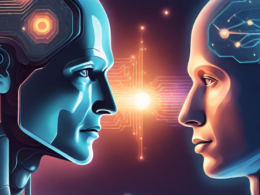Did you know we spend an average of 2 hours 15 minutes everyday browsing apps on our phone?
You must have read about data sharing policies of different service providers and checked mark countless privacy policy updates to allow websites and mobile applications to use your data.
That’s because allowing their algorithms to use our data makes the user experience more and more friendly. Here’s another fun fact for you:
By 2020, 85% of customer interactions will require no human effort!
So you agree, apps are the unavoidable truth staring us in our faces while we stare right back for around 47 times a day!

In the race to make the user experience more seamless and derive maximum value from the customers, businesses are adopting machine learning in their marketing strategies.
By now, you must be aware that machine learning algorithms use data received from different customers to enhance their businesses.
How do these machine learning algorithms really know what to find from your data?
Well, they work on three different approaches. We have discussed them in the past, let us recap them for you very quickly!
Consider taking a walk in a zoo. All animals that you come across are classified in your brain differently based on previous knowledge and awareness of the animal characteristics, features and behaviors.
This is supervised learning. In this case, your brain acts as a supervisor, relating everything you’ve seen to previously acquired knowledge and finally assigning an animal to a certain class. Simply put, supervised learning needs a supervisor.
Now imagine a child is walking in that zoo with you. This is the child’s first visit to a zoo and he has no previous knowledge of the animal kingdom!
Now if you were to not help the child, the child would be totally unsupervised when learning about these animals.
If this child was to make sense of what he saw at the zoo that day, he’ll probably describe the animals as being big or small, having wings or not, having stripes or a plain coat, having a long neck or a long trunk and the possibilities go on.
The child would consider classifying animals with most commonality and assign them to different groups. In this case, the child is completely unsupervised. This is a case of unsupervised learning.
You can read more about supervised and supervised machine learning algorithms here.
The third way is reinforcement learning. Learning is reinforced through a sequence. The input data goes through a series of commands and at every step gains some reward or incurs a fine based on the result of its predecessor.
The aim is for the algorithm to learn through experience and improve on itself loosely based on a carrot or stick approach.
In the same example, now consider the child and you are working as a team. For every animal that the child recognizes correctly, you give him a bar of chocolate and for every animal that he incorrectly identifies, you correct him while taking away half the bar from him.
These approaches are how different algorithms learn what should be done with the data. They use user data to make generic marketing seem more personalized.
In the end, the apps that you use turn out to be more user-friendly when these algorithms optimally use your data to enhance your experience.
Let’s take a look at how different apps could use machine learning to stand out
E-commerce apps
E-commerce apps are, by far, best using machine learning to support their business. A lot of aspects of online shopping are driven by algorithms.
Since e-business owners have almost no control over customers dropping off in the middle of purchases and no opportunities for real interaction with them, well-targeted marketing takes them a long way.
Focused targeting and promotions give way to more relevant customers.
Another important application is generating suitable suggestions for customers using their data, likes and preferences. You must have heard about these recommendation systems.
Machine learning algorithms are deployed to group users into similar bunches and recommend products based on each other’s choices. Accurate predictions can lead to guaranteed purchases. Amazon has itself admitted to 35% more sales thanks to their recommendation systems.
Using algorithms to rank searches is another way to go for e-commerce platforms. E-commerce businesses also cut down on costs significantly and save time by using chat-bots to handle a lot of customer complaints and requests.

Content streaming apps
The world is consuming content in an unbelievable number of ways. Gone are the days when the good old television was all the source of entertainment in our lives. A number of streaming services are hitting it big in the market and have become hot favorites for everyone!
Netflix’s recommendation systems have made content viewing easy and engaging. Users have a plethora of programs to watch from and are suggested content based on previously watched shows. This kind of personalization make searches relevant and easier.
Another raging trend is recommendation systems in music streaming apps. Spotify and Apple music are two big giants that come to mind.
How does Spotify cater to its users, you ask?
Spotify runs three algorithms across the playlists of different users and matches them to your most shuffled tunes. The algorithms do not assign weightage to any artist or band which is why a music amateur can upload his tunes for discovery.
The algorithms would simply recommend him to users who listen to his kind of music. They start with shuffling through the preferences of 100 million users to give you the best of the best!
Healthcare apps
Machine learning and artificial intelligence have been enhancing user experiences in mobile apps across industries. In healthcare apps, recording patient’s history and assessing them to identify potential risk factors, monitor their health and prescribe precautions is gaining top speed.
Practo is using machine learning algorithms to match patients to trusted doctors nearby, enable people to ask questions to certified healthcare providers and review health practitioners.
Healthcare apps will soon use algorithms to read test results and reports and reduce the average time a patient spends at the doctor’s clinic.
Media sharing apps
Photo and video sharing apps are becoming an important part of the millennial culture. Social media has taken over most of the recreational activities an average individual indulges into.
While these platforms are making a cultural impact on the population, they are using this opportunity to maximize the time and features for its users.
The popular image-sharing app, Snapchat, is using machine learning algorithms to devise interesting face/image filters.
These filters use face recognition and feature detection to identify and locate a user’s face. It then creates a mesh or a 3-D mask to help fit the intended filter on your face.
Facebook uses your data for automatic tagging, friends suggestions and rearranging your news-feed such that posts from closer friends are ranked higher.
Similarly in Instagram, algorithms change every now and then to determine the order of posts you see. Instagram stories use a lot of machine learning as well.
While a lot of social media platforms are using machine learning in extensive ways, you might have seen businesses using targeted marketing with their advertising tools.
Food Delivery apps
Food delivery apps are another raging phenomenon in the market. The industry in India is supposed to grow up to $4 billion by 2020.
Food delivery apps use demand prediction models to help their partners be ready for food orders well ahead of time. Another feature is providing real-time information where users are connected to nearby restaurants to help them save on time.
Swiggy and Zomato are the ruling giants in this space. While Swiggy was able to grow its customer interactions to $40 billion in January 2019, chatbots aren’t the only artificial intelligence device used by this maestro.
Swiggy uses image recognition to recognize properties or characteristics from food images and classify them into vegetarian/non-vegetarian, dairy-based, gluten free, etc. Swiggy also uses natural language processing to interpret food searches made in the local vernacular.
Zomato has claimed that click through and order rates improve by 15% once more personalized recommendations are made by the app’s algorithms. Zomato has recently acquired TechEagle Innovations, a drone food delivery service.

Personal transport apps
A lot of transport and transit apps have begun dominating the roads. Personal transport cab services have been hitting home runs with their strategies. Ola and Uber are using machine learning to predict demand, notify drivers of areas of high demand, reducing wait and travel time.
Ola has launched Ola Guardian for the safety of its employees. The technology uses artificial intelligence to track routes, alert route detouring and intervening in case the rider goes rogue.
Uber has employed machine learning to identify fake accounts and planned to launch self driving cars in the future.
Zoomcar, the car renting service has partnered with Onfido to help simplify the user interface. The service now allows customers to upload selfies along with their documents for faster clearance.
They also use their partner’s image recognition algorithms to ensure the rightful customers are picking up car as per the bookings.
Weather prediction apps
Weather prediction apps might feel redundant to some of us but a precise weather estimation is required by many people around us. People traveling for jobs or leisure often need an accurate estimation of weather conditions.
A number of free and paid apps have been doing the rounds for predicting weather changes. Though most smartphones already have pre-installed weather apps and Google Assistant to inform them, this does not deter them from downloading and using weather apps.

Weather & Radar is a popular app with over 10 million downloads in the country. It offers weather updates of up to any time frame from hourly to weekly to monthly.
Another good bet in this area is Skymet Weather. Skymet has 7500 locations mapped in India alone and has access to weather conditions for over 0.2 million locations worldwide. Skymet comes in 9 languages and with a supremely helpful user interface.
Machine learning is being used extensively in a number of apps worldwide. Whatever be the scope of the business, including artificial intelligence in their operations has been important to their success.
As more and more younger companies seek funding for their AI plans, the myth that only well funded, mature companies knock on the doors of artificial intelligence and machine learning is completely busted.
Which apps have got your attention when it comes to using machine learning effectively?
Let us know below in the comments section!







9 comments